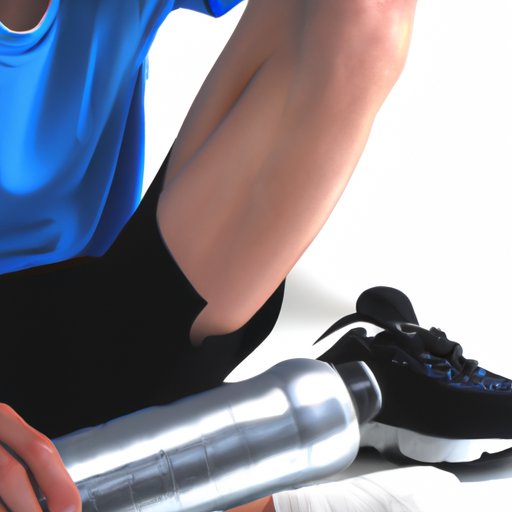Introduction
After a strenuous workout or physical activity, we often feel muscle soreness in our body. This is also known as delayed onset muscle soreness (DOMS). DOMS is caused by microscopic damage to the muscles that leads to inflammation and pain. It can range from feeling mildly tender to very painful, and usually peaks at 24-48 hours after the activity.
It’s important to take steps to prevent and reduce muscle soreness. Not only does it make exercise more enjoyable, but it also helps you stay injury-free and reach your fitness goals.
Warm Up and Cool Down
One of the best ways to reduce muscle soreness is to warm up and cool down properly before and after your workout. Warming up prepares your body for physical activity by increasing your heart rate and circulation, and cooling down helps your body return to its resting state. Both activities help reduce the risk of injury and muscle soreness.
Examples of warm-up activities include jogging, jumping jacks, and dynamic stretches. Examples of cool-down activities include walking, static stretching, and foam rolling.
Hydrate
Staying hydrated is essential for reducing muscle soreness. Water helps your muscles recover by flushing out toxins and replenishing lost fluids. Dehydration can lead to cramping, fatigue, and increased muscle soreness.
It’s important to drink plenty of water before, during, and after your workout. The general recommendation is to drink 8 ounces of water every 15-20 minutes while exercising. You should also drink plenty of water throughout the day to stay adequately hydrated.
Eat Right
Eating the right foods can also help reduce muscle soreness. Foods rich in protein, such as lean meats, dairy products, eggs, and legumes provide the building blocks for muscle repair and recovery. Additionally, foods high in antioxidants, such as fruits and vegetables, help reduce inflammation and protect against cell damage.
Some other examples of foods that can help reduce muscle soreness are complex carbohydrates like whole grains and sweet potatoes, healthy fats like nuts and avocados, and electrolyte-rich beverages like coconut water.
Change Up Your Routine
Varying your workout routine is another way to reduce muscle soreness. If you always do the same exercises, your body will become accustomed to the movements and won’t be challenged as much. This can lead to increased muscle soreness.
By changing up your routine, you can target different muscle groups and keep your body guessing. Examples of different exercises include running, strength training, HIIT workouts, yoga, Pilates, and swimming.
Get Enough Rest
Getting enough sleep is also important for reducing muscle soreness. During sleep, your body releases hormones that help repair and rebuild muscle tissue. Without adequate rest, your muscles won’t be able to recover properly, leading to increased soreness.
The recommended amount of sleep for adults is 7-9 hours per night. To ensure a good night’s sleep, try to go to bed and wake up at the same time every day, avoid caffeine and alcohol late in the day, and create a comfortable sleep environment.
Conclusion
Muscle soreness is an inevitable part of exercise, but it doesn’t have to stop you from reaching your fitness goals. By following simple tips such as warming up and cooling down, staying hydrated, eating right, varying your routine, and getting enough rest, you can reduce muscle soreness and enjoy a more comfortable workout experience.
(Note: Is this article not meeting your expectations? Do you have knowledge or insights to share? Unlock new opportunities and expand your reach by joining our authors team. Click Registration to join us and share your expertise with our readers.)
